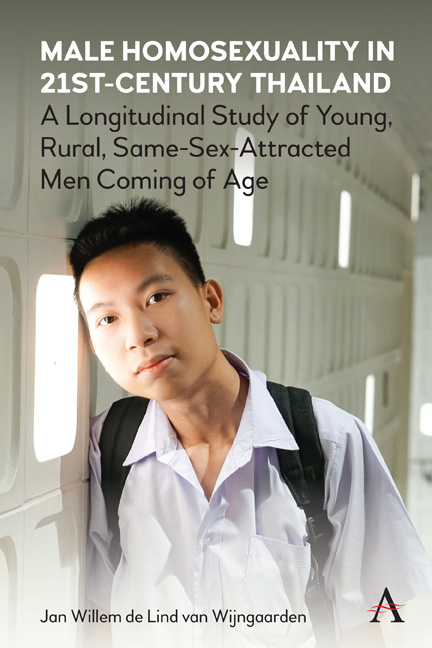 Male Homosexuality in 21st-Century Thailand
Male Homosexuality in 21st-Century Thailand Book contents
- Frontmatter
- Dedication
- Contents
- Preface
- 1 Introduction
- 2 Introducing the Research Participants
- 3 Understanding Thai Personhood
- 4 Homosexuality: A Matter of Karma?
- 5 In the Beginning … Exploring Early Awareness of Being Different
- 6 The Important Role of Gender in Understanding Homosexuality in Thailand
- 7 ‘All in the Family’: Tactics for Living and Growing Up in a Heteronormative World
- 8 How Dating Friends Plays a Role in Destabilizing Gender-Based Notions of Homosexuality
- 9 The Role of the Internet in Learning about and Experimenting with New Sexual Identities
- 10 ‘No Money, No Honey’: Love and Sex in Pursuit of a Better Life
- 11 Conclusions and Implications for HIV Service Provision and Sexuality Education
- Appendix: Glossary of Thai Terms Used in this Book
- References
- Index
2 - Introducing the Research Participants
Published online by Cambridge University Press: 23 March 2021
- Frontmatter
- Dedication
- Contents
- Preface
- 1 Introduction
- 2 Introducing the Research Participants
- 3 Understanding Thai Personhood
- 4 Homosexuality: A Matter of Karma?
- 5 In the Beginning … Exploring Early Awareness of Being Different
- 6 The Important Role of Gender in Understanding Homosexuality in Thailand
- 7 ‘All in the Family’: Tactics for Living and Growing Up in a Heteronormative World
- 8 How Dating Friends Plays a Role in Destabilizing Gender-Based Notions of Homosexuality
- 9 The Role of the Internet in Learning about and Experimenting with New Sexual Identities
- 10 ‘No Money, No Honey’: Love and Sex in Pursuit of a Better Life
- 11 Conclusions and Implications for HIV Service Provision and Sexuality Education
- Appendix: Glossary of Thai Terms Used in this Book
- References
- Index
Summary
In this chapter, the participants are briefly introduced and described, including their first sexual experiences. The chapter will end with a brief description of the two regions from which the participants were recruited in the study: the northeast and the south of Thailand.
The Participants
The 25 participants in this study were all between 18 and 19 years of age at the first interview. They all had had (or tried to have) anal sex, except one, who remained a (proud) virgin even at the final interview, nearly two years later. One of the first things to note is the young age at which the men in this study first had sex: almost all of them were under 18 years at the time. Disregarding the two men who had had some early sexual experiences with girls, and not counting the rape of one of the participants as a boy, the average age of first sex with another male among the 24 who had had sex was a little over 15 years. It is interesting to note that this is not too different from the average age of sexual debut of 14.7 found in a randomly sampled population of same-sex-attracted vocational students in northern Thailand (van Griensven et al. 2004).
The participants in the study were given pseudonymous names starting from A to Y in the order that they were first interviewed; each will be briefly discussed next.
Ake grew up in a small village in rural Phuket province in southern Thailand and moved to high school in Phuket town. His family were Muslims but not strict, and were accepting of Ake's adoption of feminine gender traits, which started during childhood. Ake went through a process of masculinization during the research period: between the first and second interviews he abruptly shed his initial gender identity of sao praphet song (‘second type of woman’, loosely translatable as ‘transgender’) according to which he had long hair and wore women's clothing occasionally, and moved to a gay concept of self with shorter hair, less make-up, men's clothes and a new Facebook page. Ake met a (younger) phu chaai (‘real man’) boyfriend who lived in his neighbourhood when he was 15 years of age, with whom he had anal sex regularly.
- Type
- Chapter
- Information
- Male Homosexuality in 21st-Century ThailandA Longitudinal Study of Young, Rural, Same-Sex-Attracted Men Coming of Age, pp. 9 - 18Publisher: Anthem PressPrint publication year: 2021
